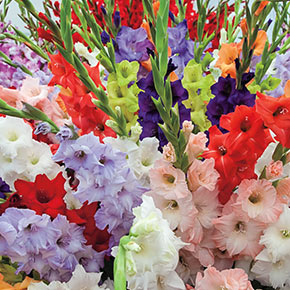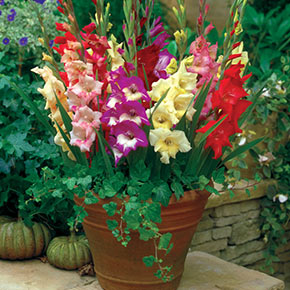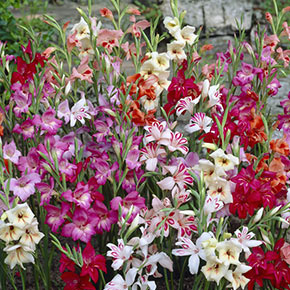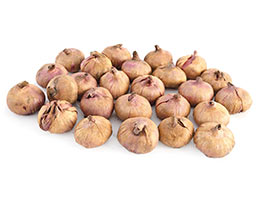
How to Plant, Grow, and Care For Gladiolus Flowers
| Botanical Name |
Gladiolus |
| Plant Type |
Corm |
| Sun Exposure |
Full sun to partial shade |
| Soil Type |
Well-drained acidic, clay, loamy or sandy soils |
| Soil pH |
Slightly acidic |
| Bloom Time |
Midsummer to early fall |
| Flower Color |
Purple, white, yellow, pink, green, red, orange |
| Hardiness Zones |
3, 4, 5, 6, 7, 8, 9, 10 (lift in zones 3-7) |
| Special Features |
Gladiolus make spectacular cut flowers, and are now available in dwarf sizes. |
A favorite for generations of gardeners, gladiolus offer spectacular color and vertical interest in the summer garden and the flower spikes are a favorite for cut-flower displays. Symbolizing strength, remembrance and integrity, gladiolus flowers can last up to a week or more in a vase. Gladiolus, also called sword lilies, are available in an array of colors and can grow from 2-5 ft. tall. They're also suitable for containers.
The official flower of August, glads provide fresh color and interest in the garden when many other flowers start to fade. Because they generally bloom about 90 days after planting, many gardeners plant corms every 10-14 days so they have continuous blooms from midsummer to fall. Gladiolus grow from corms, often called bulbs.
At K. van Bourgondien, our garden professionals are always looking for gladiolus varieties that offer spectacular colors and garden performance. With our wide selection of gladiolus bulbs for sale, you're sure to find the right color of gladiolus for your landscape or garden, and you can count on K. van Bourgondien to deliver high-quality gladiolus to your door.
Types of Gladiolus Flowers
 Hybrid Glads - Growing 3-5 ft. tall with swordlike foliage and tall flower spikes, hybrid gladiolus are known for their bright colors and garden performance. They make striking accents to flower borders and are very showy as cut flowers. Because of their height, they may require staking in the garden.
Hybrid Glads - Growing 3-5 ft. tall with swordlike foliage and tall flower spikes, hybrid gladiolus are known for their bright colors and garden performance. They make striking accents to flower borders and are very showy as cut flowers. Because of their height, they may require staking in the garden.
 Glaminis - Growing 2 ft. tall, Glamini gladiolus feature full-sized blooms on petite plants. Their brightly colored flowers are perfect for mixed borders, annual beds, tropical gardens and containers. Short and naturally sturdy, they don't require staking. Like their larger cousins, Glamini gladiolus require well-drained soil and full sun to partial shade.
Glaminis - Growing 2 ft. tall, Glamini gladiolus feature full-sized blooms on petite plants. Their brightly colored flowers are perfect for mixed borders, annual beds, tropical gardens and containers. Short and naturally sturdy, they don't require staking. Like their larger cousins, Glamini gladiolus require well-drained soil and full sun to partial shade.
 Hardy Glads - Also called Gladiolus Nanus, these gladiolus are hardy in zones 5-10. Most gladiolus are hardy in zones 8-10, and must be lifted in the fall in zones 3-7. Hardy Glads are well suited for perennial borders because of their winter hardiness and vertical growth habit. Like other glads, they are showy cut flowers.
Hardy Glads - Also called Gladiolus Nanus, these gladiolus are hardy in zones 5-10. Most gladiolus are hardy in zones 8-10, and must be lifted in the fall in zones 3-7. Hardy Glads are well suited for perennial borders because of their winter hardiness and vertical growth habit. Like other glads, they are showy cut flowers.
When to Plant Gladiolus Bulbs
Gladiolus corms can be planted in mid-spring, after the last spring frost. If you want a continual supply of cut flowers or showy color in the garden, continue planting gladiolus bulbs every two weeks until mid-July.
Where to Plant Gladiolus
While gladiolus can grow in most areas of the United States, they are not winter hardy. First, determine your grow zone. In zones 3-7, most gladiolus must be lifted in the fall or grown as annuals. Hybrid gladiolus can be grown in the backs of perennial borders, in cutting gardens--and even vegetable gardens. Many gardeners plant gladiolus where early spring crops such as peas and lettuces grew. Gladiolus prefer well-drained soil and full sun to partial shade. Because of their shorter size, Glamini gladiolus are a favorite for patio containers, window boxes and the fronts of flower beds.
When Do Gladiolus Bloom?
Gladiolus bulbs generally bloom 70-100 days from planting, depending on the lateness in the season.

How to Plant Gladiolus Bulbs
When planting gladiolus bulbs, you can either dig individual holes or use the trench method. After the last spring frost, dig a trench 8" deep. Add compost and bulb food to the trench. Cover with several inches of soil. Plant the bulbs pointed sides up about 4" deep and 4-6" apart. For cutting gardens, plant gladiolus in rows. For flower gardens, planting in groups of 10 bulbs in a roundish or oval-shaped hole creates a more natural look. Cover the bulbs with soil and water well. Adding a thin layer of mulch will conserve moisture and keep the roots cool. Tall-growing varieties may require staking.
Materials You'll Need
While a shovel or trowel is great for digging, some gardeners prefer using an auger and drill. Both the Improved Bulb Auger and KneeSaver Planting Tool are time savers. Using an all-natural, slow-release fertilizer, like Van Bourgondien 100% Natural Bulb Food, at planting time can also give your gladiolus a boost. For taller varieties, you'll also need stakes.
Growing Gladiolus
Gladiolus are fairly easy to grow. The main thing is to water well throughout the growing season. They need the equivalent of about 1" of rainfall weekly. When flower spikes first appear, add a slow-release fertilizer. Fertilize again after the flowers are picked. Throughout the season, keep the growing area as weed-free as possible. Gladiolus don't like to compete with weeds. If you want a tidy look in the garden, remove or deadhead the spent flowers.

Harvesting & Storage
Gladiolus are treasured as cut flowers. To get the most out of your cut-flower display, harvest the flowers when one or two flowers on the spike start to open. Gladiolus usually bloom from the bottom up, so look for flowers at the bottom of the flower spike. Harvest either in early morning or the evening--not during the heat of the day. Use a sharp knife to cut the stem at a diagonal. If you want to re-use the corms the following year, make sure to leave at least four leaves on the plant.
Digging up Gladiolus Bulbs
If you live in zones 8-10, you can leave your gladiolus bulbs in the ground over winter. In zones 3-7, you can either treat them as annuals or dig up the corms and store them in a place where they won't freeze over winter. After the flowers fade, wait 4-6 weeks before digging up the corms. Remove as much soil as possible from the corms and cut off the flower stalk 1" above the corm.
How Do You Store Gladiolus Bulbs?
A basement where the temperatures are 40-50°F is ideal for storing gladiolus bulbs over winter. Store the bulbs in peat moss, or paper or cloth bags. The corms can then be replanted in the spring.
Pests & Diseases
Among the pests that can attack gladiolus are aphids, thrips, whiteflies and spider mites. Inspect your gladiolus frequently for signs of pests. Organic neem oil is effective against many insect pests. If you've had problems with thrips, another option is to soak the bulbs for 2-3 hours just before planting in a solution of 4 teaspoons of Lysol in 1 gallon of water.
Gladiolus are also susceptible to diseases like botrytis, crown rot, rust, wilt and mosaic virus. One way to avoid disease problems is to start with quality, healthy bulbs. If a plant shows signs of disease, destroy it and don't plant the corms again. Also practice pest control so that pests don't spread disease.
FAQs
Do gladiolus come back every year? Gladiolus can come back year after year. However, because they aren't winter hardy, gardeners in zones 3-7 must dig them up in the fall and store them indoors over winter. In zones 8-10, gladiolus corms can be left in the ground over winter, and they will grow and bloom the following year.
How tall do gladiolus get? Hybrid gladiolus grow up to 5' tall while Glamini or dwarf gladiolus grow 2' tall.
When should you cut back gladiolus? Gladiolus can be cut back after the first fall frost or 4-6 weeks after blooming. If you are digging up the corms and storing them indoors over winter, the stalk is cut after they are dug up.
Do gladioli bulbs multiply? Gladiolus grow from corms and, under good growing conditions, can multiply from year to year.
Have another question? Return to the Customer Service Help page or send an e-mail directly to Customer Service
 MENU
MENU Plant Finder
Plant Finder
 Help
Help













